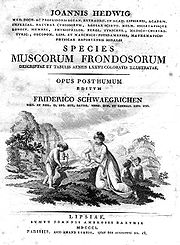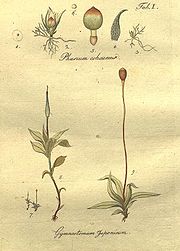
Johann Hedwig
Encyclopedia


Germany
Germany , officially the Federal Republic of Germany , is a federal parliamentary republic in Europe. The country consists of 16 states while the capital and largest city is Berlin. Germany covers an area of 357,021 km2 and has a largely temperate seasonal climate...
botanist notable for his studies of moss
Moss
Mosses are small, soft plants that are typically 1–10 cm tall, though some species are much larger. They commonly grow close together in clumps or mats in damp or shady locations. They do not have flowers or seeds, and their simple leaves cover the thin wiry stems...
es (for which he is sometimes called the father of bryology
Bryology
Bryology is the branch of botany concerned with the scientific study of bryophytes . Bryophytes were first studied in detail in the 18th century...
), in particular the observation of sexual reproduction in the cryptogams
Cryptogams
The name cryptogams is used fairly widely as a phrase of convenience, although regarded as an obsolete taxonomic term. A cryptogam is a plant that reproduces by spores...
.
He was born in Romania
Romania
Romania is a country located at the crossroads of Central and Southeastern Europe, on the Lower Danube, within and outside the Carpathian arch, bordering on the Black Sea...
, and studied medicine at the University of Leipzig
University of Leipzig
The University of Leipzig , located in Leipzig in the Free State of Saxony, Germany, is one of the oldest universities in the world and the second-oldest university in Germany...
, receiving an M.D. in 1759. He then practiced as a physician for the next twenty years, during which time he pursued botany
Botany
Botany, plant science, or plant biology is a branch of biology that involves the scientific study of plant life. Traditionally, botany also included the study of fungi, algae and viruses...
as a hobby, collecting in the morning before work and then studying his accumulation in the evening. He also acquired a microscope
Microscope
A microscope is an instrument used to see objects that are too small for the naked eye. The science of investigating small objects using such an instrument is called microscopy...
and a small library.
Over time his publications attracted attention, and he eventually achieved both a professorship at Leipzig (first in medicine in 1786, then in botany in 1789), and direction of the Leipzig Botanical Garden
Leipzig Botanical Garden
Leipzig Botanical Garden , , is a botanical garden maintained by the University of Leipzig, and located at Linnéstraße 1, Leipzig, Saxony, Germany. It is the oldest botanical garden in Germany and among the oldest in the world, and open daily without charge.Leipzig's botanical garden dates back to...
.
Skilled at both microscopy and biological illustration, he was able to identify moss antheridia and archegonia. He directly observed the germination of spores and formation of the protonema
Protonema
A protonema is a thread-like chain of cells that forms the earliest stage of a bryophyte life cycle...
. He was less successful with other sporophyte
Sporophyte
All land plants, and some algae, have life cycles in which a haploid gametophyte generation alternates with a diploid sporophyte, the generation of a plant or algae that has a double set of chromosomes. A multicellular sporophyte generation or phase is present in the life cycle of all land plants...
s, being unable to determine the life cycles of fern
Fern
A fern is any one of a group of about 12,000 species of plants belonging to the botanical group known as Pteridophyta. Unlike mosses, they have xylem and phloem . They have stems, leaves, and roots like other vascular plants...
s or fungi, but he did make useful observations on the algae
Algae
Algae are a large and diverse group of simple, typically autotrophic organisms, ranging from unicellular to multicellular forms, such as the giant kelps that grow to 65 meters in length. They are photosynthetic like plants, and "simple" because their tissues are not organized into the many...
Chara and Spirogyra
Spirogyra
Spirogyra is a genus of filamentous green algae of the order Zygnematales, named for the helical or spiral arrangement of the chloroplasts that is diagnostic of the genus. It is commonly found in freshwater areas, and there are more than 400 species of Spirogyra in the world. Spirogyra measures...
and he made it clear that he was not the first to get new plants from sowing the spores of mosses, C. Meese had done it before him.
His chief work, Species Muscorum Frondosorum was published posthumously, in 1801. It describes nearly all the moss species then known, and is the starting point for nomenclature of all mosses, except for the sphagnum
Sphagnum
Sphagnum is a genus of between 151 and 350 species of mosses commonly called peat moss, due to its prevalence in peat bogs and mires. A distinction is made between sphagnum moss, the live moss growing on top of a peat bog on one hand, and sphagnum peat moss or sphagnum peat on the other, the...
group.
In April, 1788 he was elected a Fellow of the Royal Society. In 1790, he was elected a foreign member of the Royal Swedish Academy of Sciences
Royal Swedish Academy of Sciences
The Royal Swedish Academy of Sciences or Kungliga Vetenskapsakademien is one of the Royal Academies of Sweden. The Academy is an independent, non-governmental scientific organization which acts to promote the sciences, primarily the natural sciences and mathematics.The Academy was founded on 2...
.
Hedwig is commemorated both by the moss genus Hedwigia as well as a journal Hedwigia.

